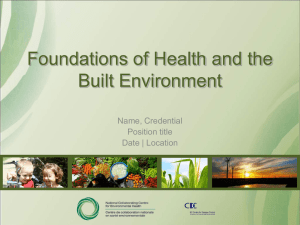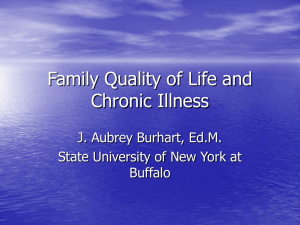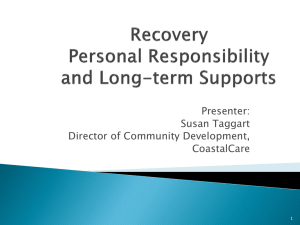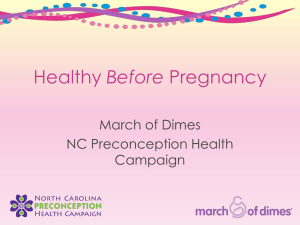GROWING UP IN IRELAND National Longitudinal Study of Children
advertisement
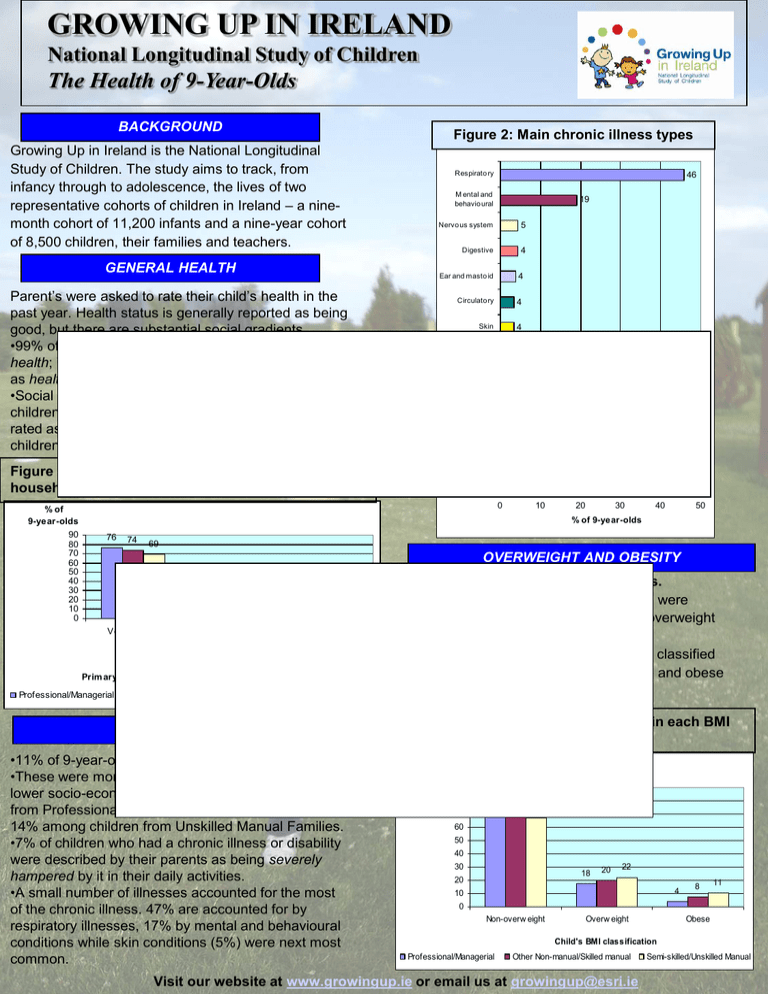
GROWING UP IN IRELAND National Longitudinal Study of Children The Health of 9-Year-Olds BACKGROUND Figure 2: Main chronic illness types Growing Up in Ireland is the National Longitudinal Study of Children. The study aims to track, from infancy through to adolescence, the lives of two representative cohorts of children in Ireland – a ninemonth cohort of 11,200 infants and a nine-year cohort of 8,500 children, their families and teachers. GENERAL HEALTH Parent’s were asked to rate their child’s health in the past year. Health status is generally reported as being good, but there are substantial social gradients. •99% of parents indicated that their child was in good health; 74% rated their child as very healthy and 25% as healthy, but with a few minor problems. •Social gradients in health status are clear. 76% of children from Professional/Managerial groups were rated as being very healthy compared with 69% of children from Semi-skilled/Unskilled backgrounds. Figure 1: Parent's rating of children's health, by household social class Respirato ry 19 Nervo us system 5 Digestive 4 Ear and masto id 4 Circulato ry 4 Skin 4 Co ngenital and chro mo so mal 3 Genito urinary 3 M usculo skeletal 3 Endo crine and metabo lic 2 Eye and A dnexa 2 1 No t classified 0 % of 9-year-olds 90 80 70 60 50 40 30 20 10 0 46 M ental and behavio ural 10 20 30 40 50 % of 9-year-olds 76 74 69 OVERWEIGHT AND OBESITY 23 25 29 1 Very Healthy Healthy, but a few minor problems 2 2 Sometimes quite ill/Almost alw ays unw ell Prim ary Caregiver’s perception of the study child’s health status Professional/Managerial Other Non-manual/Skilled Manual Semi-skilled/Unskilled Manual CHRONIC ILLNESS •11% of 9-year-olds had a chronic illness or disability. •These were more concentrated among children from lower socio-economic backgrounds – 10% of children from Professional/Managerial families compared with 14% among children from Unskilled Manual Families. •7% of children who had a chronic illness or disability were described by their parents as being severely hampered by it in their daily activities. •A small number of illnesses accounted for the most of the chronic illness. 47% are accounted for by respiratory illnesses, 17% by mental and behavioural conditions while skin conditions (5%) were next most common. These are major public health issues. Overall, 74% of nine-year-old children were classified as non-overweight, 19% as overweight and 7% as obese. Girls were more likely than boys to be classified as overweight (22% compared to 17%) and obese (8% compared to 6%). Figure 3: Percentage of children within each BMI category by household social class % of 9-year-olds 90 80 78 70 73 67 60 50 40 30 18 20 20 22 4 10 8 11 0 Non-overw eight Overw eight Obese Child's BMI classification Professional/Managerial Other Non-manual/Skilled manual Visit our website at www.growingup.ie or email us at growingup@esri.ie Semi-skilled/Unskilled Manual GROWING UP IN IRELAND National Longitudinal Study of Children The Health of 9-Year-Olds BACKGROUND Figure 2: Main chronic illness types Growing Up in Ireland is the National Longitudinal Study of Children. The study aims to track, from infancy through to adolescence, the lives of two representative cohorts of children in Ireland – a ninemonth cohort of 11,200 infants and a nine-year cohort of 8,500 children, their families and teachers. GENERAL HEALTH Parent’s were asked to rate their child’s health in the past year. Health status is generally reported as being good, but there are substantial social gradients. •99% of parents indicated that their child was in good health; 74% rated their child as very healthy and 25% as healthy, but with a few minor problems. •Social gradients in health status are clear. 76% of children from Professional/Managerial groups were rated as being very healthy compared with 69% of children from Semi-skilled/Unskilled backgrounds. Figure 1: Parent's rating of children's health, by household social class Respirato ry 19 Nervo us system 5 Digestive 4 Ear and masto id 4 Circulato ry 4 Skin 4 Co ngenital and chro mo so mal 3 Genito urinary 3 M usculo skeletal 3 Endo crine and metabo lic 2 Eye and A dnexa 2 1 No t classified 0 % of 9-year-olds 90 80 70 60 50 40 30 20 10 0 46 M ental and behavio ural 10 20 30 40 50 % of 9-year-olds 76 74 69 OVERWEIGHT AND OBESITY 23 25 29 1 Very Healthy Healthy, but a few minor problems 2 2 Sometimes quite ill/Almost alw ays unw ell Prim ary Caregiver’s perception of the study child’s health status Professional/Managerial Other Non-manual/Skilled Manual Semi-skilled/Unskilled Manual CHRONIC ILLNESS •11% of 9-year-olds had a chronic illness or disability. •These were more concentrated among children from lower socio-economic backgrounds – 10% of children from Professional/Managerial families compared with 14% among children from Unskilled Manual Families. •7% of children who had a chronic illness or disability were described by their parents as being severely hampered by it in their daily activities. •A small number of illnesses accounted for the most of the chronic illness. 47% are accounted for by respiratory illnesses, 17% by mental and behavioural conditions while skin conditions (5%) were next most common. These are major public health issues. Overall, 74% of nine-year-old children were classified as non-overweight, 19% as overweight and 7% as obese. Girls were more likely than boys to be classified as overweight (22% compared to 17%) and obese (8% compared to 6%). Figure 3: Percentage of children within each BMI category by household social class % of 9-year-olds 90 80 78 70 73 67 60 50 40 30 18 20 20 22 4 10 8 11 0 Non-overw eight Overw eight Obese Child's BMI classification Professional/Managerial Other Non-manual/Skilled manual Visit our website at www.growingup.ie or email us at growingup@esri.ie Semi-skilled/Unskilled Manual GROWING UP IN IRELAND National Longitudinal Study of Children The Health of 9-Year-Olds BACKGROUND Figure 2: Main chronic illness types Growing Up in Ireland is the National Longitudinal Study of Children. The study aims to track, from infancy through to adolescence, the lives of two representative cohorts of children in Ireland – a ninemonth cohort of 11,200 infants and a nine-year cohort of 8,500 children, their families and teachers. GENERAL HEALTH Parent’s were asked to rate their child’s health in the past year. Health status is generally reported as being good, but there are substantial social gradients. •99% of parents indicated that their child was in good health; 74% rated their child as very healthy and 25% as healthy, but with a few minor problems. •Social gradients in health status are clear. 76% of children from Professional/Managerial groups were rated as being very healthy compared with 69% of children from Semi-skilled/Unskilled backgrounds. Figure 1: Parent's rating of children's health, by household social class Respirato ry 19 Nervo us system 5 Digestive 4 Ear and masto id 4 Circulato ry 4 Skin 4 Co ngenital and chro mo so mal 3 Genito urinary 3 M usculo skeletal 3 Endo crine and metabo lic 2 Eye and A dnexa 2 1 No t classified 0 % of 9-year-olds 90 80 70 60 50 40 30 20 10 0 46 M ental and behavio ural 10 20 30 40 50 % of 9-year-olds 76 74 69 OVERWEIGHT AND OBESITY 23 25 29 1 Very Healthy Healthy, but a few minor problems 2 2 Sometimes quite ill/Almost alw ays unw ell Prim ary Caregiver’s perception of the study child’s health status Professional/Managerial Other Non-manual/Skilled Manual Semi-skilled/Unskilled Manual CHRONIC ILLNESS •11% of 9-year-olds had a chronic illness or disability. •These were more concentrated among children from lower socio-economic backgrounds – 10% of children from Professional/Managerial families compared with 14% among children from Unskilled Manual Families. •7% of children who had a chronic illness or disability were described by their parents as being severely hampered by it in their daily activities. •A small number of illnesses accounted for the most of the chronic illness. 47% are accounted for by respiratory illnesses, 17% by mental and behavioural conditions while skin conditions (5%) were next most common. These are major public health issues. Overall, 74% of nine-year-old children were classified as non-overweight, 19% as overweight and 7% as obese. Girls were more likely than boys to be classified as overweight (22% compared to 17%) and obese (8% compared to 6%). Figure 3: Percentage of children within each BMI category by household social class % of 9-year-olds 90 80 78 70 73 67 60 50 40 30 18 20 20 22 4 10 8 11 0 Non-overw eight Overw eight Obese Child's BMI classification Professional/Managerial Other Non-manual/Skilled manual Visit our website at www.growingup.ie or email us at growingup@esri.ie Semi-skilled/Unskilled Manual GROWING UP IN IRELAND National Longitudinal Study of Children The Health of 9-Year-Olds BACKGROUND Figure 2: Main chronic illness types Growing Up in Ireland is the National Longitudinal Study of Children. The study aims to track, from infancy through to adolescence, the lives of two representative cohorts of children in Ireland – a ninemonth cohort of 11,200 infants and a nine-year cohort of 8,500 children, their families and teachers. GENERAL HEALTH Parent’s were asked to rate their child’s health in the past year. Health status is generally reported as being good, but there are substantial social gradients. •99% of parents indicated that their child was in good health; 74% rated their child as very healthy and 25% as healthy, but with a few minor problems. •Social gradients in health status are clear. 76% of children from Professional/Managerial groups were rated as being very healthy compared with 69% of children from Semi-skilled/Unskilled backgrounds. Figure 1: Parent's rating of children's health, by household social class Respirato ry 19 Nervo us system 5 Digestive 4 Ear and masto id 4 Circulato ry 4 Skin 4 Co ngenital and chro mo so mal 3 Genito urinary 3 M usculo skeletal 3 Endo crine and metabo lic 2 Eye and A dnexa 2 1 No t classified 0 % of 9-year-olds 90 80 70 60 50 40 30 20 10 0 46 M ental and behavio ural 10 20 30 40 50 % of 9-year-olds 76 74 69 OVERWEIGHT AND OBESITY 23 25 29 1 Very Healthy Healthy, but a few minor problems 2 2 Sometimes quite ill/Almost alw ays unw ell Prim ary Caregiver’s perception of the study child’s health status Professional/Managerial Other Non-manual/Skilled Manual Semi-skilled/Unskilled Manual CHRONIC ILLNESS •11% of 9-year-olds had a chronic illness or disability. •These were more concentrated among children from lower socio-economic backgrounds – 10% of children from Professional/Managerial families compared with 14% among children from Unskilled Manual Families. •7% of children who had a chronic illness or disability were described by their parents as being severely hampered by it in their daily activities. •A small number of illnesses accounted for the most of the chronic illness. 47% are accounted for by respiratory illnesses, 17% by mental and behavioural conditions while skin conditions (5%) were next most common. These are major public health issues. Overall, 74% of nine-year-old children were classified as non-overweight, 19% as overweight and 7% as obese. Girls were more likely than boys to be classified as overweight (22% compared to 17%) and obese (8% compared to 6%). Figure 3: Percentage of children within each BMI category by household social class % of 9-year-olds 90 80 78 70 73 67 60 50 40 30 18 20 20 22 4 10 8 11 0 Non-overw eight Overw eight Obese Child's BMI classification Professional/Managerial Other Non-manual/Skilled manual Visit our website at www.growingup.ie or email us at growingup@esri.ie Semi-skilled/Unskilled Manual

